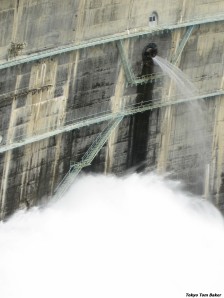This is Part 8 of a 47-part series of weekly blog posts looking at curries from each of Japan’s 47 prefectures.
The Kurobe River is short but steep. It runs only 85 kilometers from Mt. Washiba in Toyama Prefecture, but it falls nearly 3 kilometers over that distance. Where it empties into the Sea of Japan, it has created an alluvial fan where the town of Kurobe stands.
Because of its steep fall, the river was a good candidate for a hydroelectric project. The Kurobe Dam, Japan’s tallest at 186 meters, was built across it in a major postwar construction project from 1956 to 1963 that cost 171 lives in accidents.According to its official website, the dam now generates enough electricity to power a million households.
The dam is also a popular tourist site. Its visitors have included yours truly, seen a few years ago in the photo at the top of this entry. (Look at those little people on top of the dam in the background for scale.) Although the dam is in Toyama Prefecture, the usual way to reach it is to drive to Ogisawa Station in Nagano Prefecture and then catch an electric bus that takes you through the mountains and across the prefectural border via a 6.1-kilometer tunnel that was built to as an access route to the construction project.
Although most famous as the site of an engineering feat, the Kurobe River is also known for the quality of its water, especially the cold springs that bubble up in the coastal town of Kurobe after filtering through the alluvial fan. It’s called Kurobe Meisui—literally, Kurobe’s famous water.
I’ve never been to the town of Kurobe, so I’ve never tasted this water for myself. Until today, the closest I had ever come was drinking from a spring high above the river at the Kurobe dam. You could say that I drank a precursor of Kurobe Meisui.
Today, I tasted one of several varieties of Kurobe Meisui curry – a black “soup curry” made with the famous water. While standard Japanese curry is served on a plate with rice, soup curry is served in a bowl, with rice in a separate bowl. You eat the curry by dipping spoonfuls of rice in it. This curry certainly was soupy.
In addition to the famous Kurobe water—clearly the dominant ingredient—this curry also contains about two small bites of chicken, fruits and vegetables minced too finely to distinguish (listed as onions, carrots, apples, ginger and garlic), tomato puree, flour, chutney, curry power, salt…
 Ah, salt. This brings us to the fact that Kurobe Meisui is not the only famous water in Toyama Prefecture. In recent years the prefecture has also been promoting its “deep seawater,” piped up from beyond the continental shelf in Toyama Bay. If you’ve been following “Around Japan in 47 Curries,” you know that Tsuruga Bay in Shizuoka Prefecture is Japan’s deepest at 2,500 meters, but the 1,000-meter depth of Toyama Bay is still impressive.
Ah, salt. This brings us to the fact that Kurobe Meisui is not the only famous water in Toyama Prefecture. In recent years the prefecture has also been promoting its “deep seawater,” piped up from beyond the continental shelf in Toyama Bay. If you’ve been following “Around Japan in 47 Curries,” you know that Tsuruga Bay in Shizuoka Prefecture is Japan’s deepest at 2,500 meters, but the 1,000-meter depth of Toyama Bay is still impressive.
According to a Toyama prefectural government website:
“Three major positive characteristics of deep seawater are its low-temperature stability, inorganic nutrient richness, and purity. Its low-temperature stability aspect is utilized in the cultivation of cold water aquafarming. Through this, we have been able to significantly eliminate costs related to the conventional method of aquafarming, which required the cooling of surface seawater.
“Furthermore, deep seawater is receiving attention due to its balance of essential minerals including calcium and magnesium for use in health drinks and foods, pharmaceutical products, and other fields.”
According to the label of my Toyama soup curry, the salt it contains is made from Toyama Bay deep seawater.
The ingredients continue with cumin, black pepper, butter, malt extract, bouillon, nam pla fish sauce, sugar, and the usual range of unpronounceables. Eating this curry created a moderate spicy burn that I could feel at the back of my throat as much as on my tongue. I broke out in a sweat while eating it, which might be due to its spiciness or due to the fact that it was fresh off the stove and I was eating it in July with the windows open.
In any case, its was spicy enough that I’m still not really sure what that pure Kurobe Meisui water is supposed to taste like.
Tags: Around Japan in 47 curries, curry, dam, Kurobe, river, Toyama, Water






Leave a comment